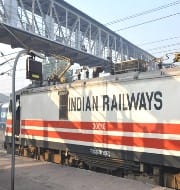NFR Zone of Indian Railways Starts Using HOG Technology for Running Trains
Two trains, Delhi-Dibugarh Bramhaputra Mail Special and New Delhi-Agartala Rajdhani Special have started running with HOG technology for their journey up to New Jalpaiguri. During the return journey also, both the trains are supposed to use this technology only.
In the HOG Technology, the entire electrical load of AC, lights, fans and other electrical equipment of the complete rake will be taken from electric locomotive running on electric traction and as a result of this, a lot of diesel will be saved during the entire journey.
HOG Technology will be available at Rs 6 per unit as compared to EOG system that costs Rs 22 per unit now. This technology is not only going to save on the power costs but it will also be of help in creating a cleaner environment for the future generations to come. The diesel fuel saving in these two trains is pegged at around 1132 kilo litre per annum and this will save the total fuel cost of Rs 7.16 crores per annum.
Background
As of now, the Linke Hofmann Busch (HFB) coaches have been designed to run on End on Generation (EOG) system in which two power cars employing two DG sets are set on either end. These are being modified to run on Head On Generation (HOG) Technology. In the NFR Zone, 23 rakes have already been made HOG-compliant out of the total 49 LHB rakes and these will be deployed as soon as the train services resume in the country, after the lockdown is over.
The rest of the rakes will also be made HOG-compliant by the end of the year 2020-2021.
In the HOG system, power supply will be taken from overhead power lines through pantograph and it will be transmitted to the train engine. That power will then be distributed to the coaches for train lighting, air conditioning, fans and other equipment that runs on the electrical power supply.
As the total zone has been sanctioned for electrification, the LHB coaches are being modified in various depots and trial runs are also being conducted. There will also be better reliability due to the reduced number of power generating equipment, low maintenance and reduced train weight. The power generator cars which are in use as of now, consume about 100 litres diesel per hour resulting in substantial fuel costs and fume emission during the run.
Once all the trains are shifted to the HOG technology, there will be huge savings in the fuel bills resulting in saving of foreign exchanges required in importing fuel. The diesel generated also pollutes the air by producing about 1724.6 tons of carbon-di-oxide and 7.48 tons of Nitrogen Oxide per annum apart from producing 100 db of noise. With the use of the new technology, there will be zero emission of carbon di oxide and nitrogen oxide apart from it being completely silent.
Month: Current Affairs - July, 2020


